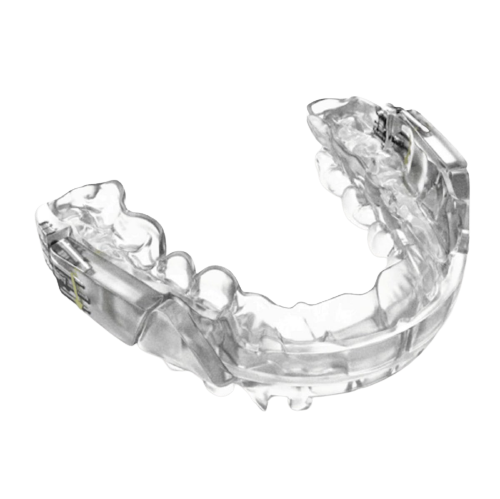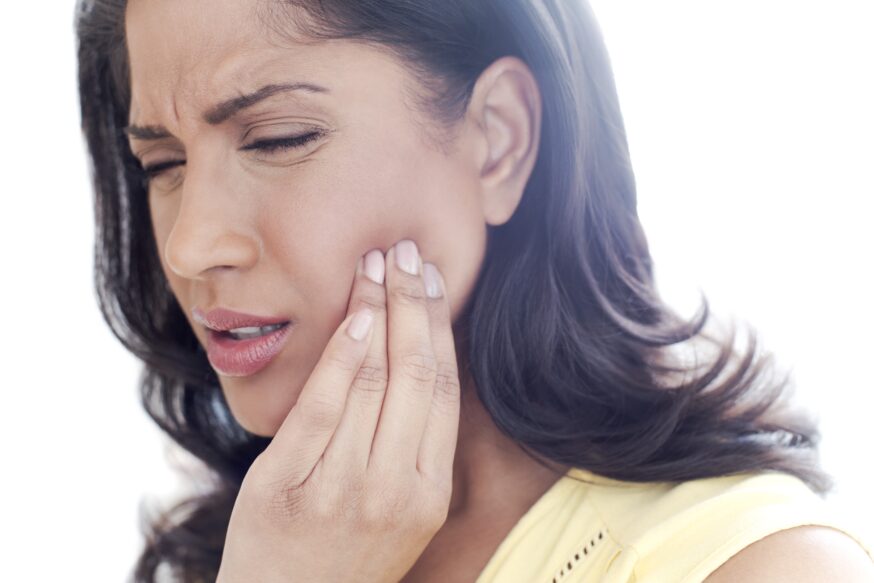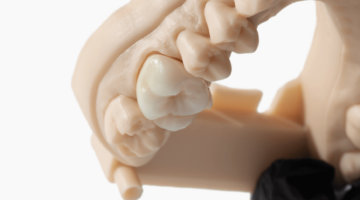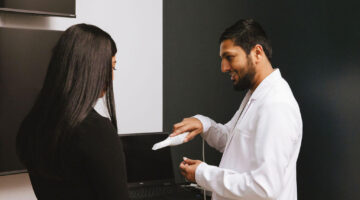The temporomandibular joints (TMJs) are arguably the hardest-working joints in the body. They connect the jaw to the skull and slide like a hinge to give a person’s jaw an impressive range of motion. That includes side-to-side, back-and-forward, and up-and-down movements—all of which are essential for chewing and speaking.
But for some patients, overuse, trauma, or even genetic factors can beget Temporomandibular Joint Disorders (TMDs), which cause facial pain, inflammation, dysfunction, and a host of other unpleasant symptoms. An estimated 5-12% of the population has a temporomandibular joint and muscle disorder. TMDs can cause pain in the jaw and the surrounding muscles as well as stress and trauma.
TMDs and TMJ are usually treated by dentists and ear, nose, and throat (ENT) doctors. You can help patients suffering from TMJ by learning more about helpful TMJ treatment devices from Dandy dental lab and some at-home best practices for noticeable TMJ relief.
TMJ vs TMD
What causes TMJ pain?
Today, approximately 10 million Americans are affected by a TMD. For the vast majority of these people, the problem is relatively minor, with discomfort typically being fleeting and cyclical.
More painful TMJ disorders tend to occur if there is damage to or around the site of the temporomandibular joint. According to the Mayo Clinic, the most common causes of TMDs include:
- The disk eroding
- The disk moving out of its proper alignment
- Arthritis damaging the joint’s cartilage
- A blow or impact damaging the joint
Additionally, various risk factors can cause a patient to develop TMJ problems, including a traumatic injury, chronic teeth grinding or clenching, connective tissue diseases, or certain types of arthritis.
Sleep apnea with Dandy
Dentists can offer both the Herbst and the Dorsal intraoral device for sleep apnea with Dandy. Both products are 3D printed to ensure a high level of accuracy and comfort. This ensures a high degree of efficacy when treating sleep apnea.

Identifying TMJ pain in you dental patients
To diagnose TMJ or a TMD, you can begin with an informal test:
- Have the patient open and close their mouth, then listen to and feel the jaw. Notice any cracking or popping sounds, as well as any physical irregularities or imbalances.
- Observe the range of motion in the jaw.
- Press on areas around the jaw to identify sites of pain or discomfort.
Next, ask patients about their pain and symptoms
TMJ/TMD symptoms can include:
- Jaw pain
- Ear pain
- Difficulty chewing
- Facial pain
- Locking of the joint
- Migraines
Ask the patient a series of questions for TMJ or TMD
- Do you have frequent or regular headaches upon awakening, or in the late afternoon?
- Are your jaw muscles sore or tender?
- Are your joints sore or tender when you eat or chew?
- Have you ever received an injury to your jaw or face?
- If yes, please describe the injury.
- Do your joints make any noise such as snapping, clicking, or popping?
- Do your joints lock when you are trying to open or close?
- Do you have any teeth that are sensitive, sore, aching, or uncomfortable?
- Have you ever worn a splint or nightguard?
- If yes: How many?
- Are you taking or have you taken any medication for these symptoms?
- If yes, describe the medication.
- Have you ever seen a dentist or a TMJ specialist for treatment of any of the above symptoms?
- If yes, please share more details about these visits.
Finally, order tests and imaging to confirm the issue:
- Dental X-rays to examine the teeth and jaw
- CT scan to provide detailed images of the bones involved with the joint
- MRI to reveal problems with the joint’s disk or surrounding soft tissue
- In select cases, an arthroscopy to insert a small camera into the joint space
Dental applications for TMJ relief
TMJ symptoms may go away without treatment in mild cases. At times, medications, including anti-inflammatories such as ibuprofen, low doses of antidepressants, or muscle relaxers, can be the first low-effort course of action to try to assist with pain relief, bruxism control, and sleeplessness.
If symptoms persist, the next course of action may be the use of oral appliances. Oral appliances are one of the most common and effective treatment options for TMJ and TMDs.
An occlusal appliance, splint, or orthotic device is a specially designed mouth guard for people who grind their teeth, have a history of pain and dysfunction associated with their bite or TMJ, or have completed oral reconstruction. These devices not only protect the teeth from harmful habits but also support the TMJ and the muscles that are used in chewing. They are designed to guide the jaw as it moves side-to-side and front-to-back and prevent it from moving into painful and/or harmful positions.
Occlusal appliances are often customized to suit the specific needs of a patient. Patients will need support in different areas, depending if the root cause of the TMJ/TMD is due to the muscles or the joint itself.
There are many TMJ products in the market, but there are three primary buckets of oral appliances:
- Deprogrammers: Traditional TMJ appliances with a build-up on the anterior to separate the arch.
- Gelbs: Lower arch appliance, traditionally with a cutaway anterior and wire instead for reinforcement.
- Unique Mechanism: Other options to treat TMJ with a unique mechanism (i.e. NTI with minimal coverage and Dawson with both arches)
Given the many variations of oral appliances available and the variety of products offered by each dental lab, the process of narrowing down your choice of oral appliance can be incredibly difficult for doctors.
Dandy simplifies this process by offering four appliances that cover the entire market:
NTI (Nociceptive Trigeminal Inhibition)
This small, unobtrusive device rests on the anteriors to avoid occlusion of the posterior teeth to inhibit bruxism and relieve stress. It covers only teeth #6-9 on the upper arch.
Ideal use cases of NTI
Works well for cases where the goal is to prevent any form of bruxism, rather than mitigate the impact or pain
Very helpful for temporal headache patients
Good for treating TMD cases where the root cause is a muscle problem
Anterior Deprogrammer
This device covers the entire arch and discludes the posteriors via an anterior ramp to retrain jaw muscles and prevent bruxing. It is primarily used on the upper arch.
Ideal use cases of Anterior Deprogrammer
Works well for cases where you want full arch coverage and protection, but also want to prevent occlusion
Good for treating TMD cases where the root cause is a muscle problem
Gelb
This device sits on the posteriors and repositions to mandible to control the positioning of the jaw, avoid excess force, and maintain the mandible arch shape. It also brings the condyle into a more anterior position, resulting in an inferior position in the fossa and an increase in the vertical opening, which can relieve pain.
Ideal use cases of Gelb
Good fit for cases where it is important to provide support and relieve pain in the TMJ
Works well for patients who struggle with airway obstruction given the anterior design
Dawson B-splint
This device covers both arches and avoids occlusion of the posteriors to inhibit bruxism and relieve stress while allowing horizontal movement.
Ideal use cases of Dawson B-splint
Good fit for cases where it is important to provide full arch coverage and support excursive movements, rather than prevent them
Good for long-term use and protection for those with significant parafunction
Eliminates the possibility of posterior super eruption
In more severe TMJ disorders, surgery may be necessary to fix the underlying problems.
Leveraging digital dentistry for patients with TMJ pain
Regardless of what type of stabilization splint the dentist recommends, it’s paramount that the dental appliance is precisely molded to perfectly fit the patient’s mouth. Whether the wrong device is recommended or the right device is improperly sized, either result could exacerbate the existing condition.
This is why dentists are increasingly moving toward digital dental technologies and workflows, such as:
- Intraoral scanners – These dental devices enable dentists to instantly capture dental impressions to automatically register the size and shape of each tooth.
- CAD/CAM technology – CAD/CAM technology enables dentists to send digital scans instantly. Once the digital laboratory receives the scans, the team can instantly review them to confirm that they’re accurate or request a retake. If the scan is usable, the design team can make slight adjustments to ensure proper spacing and alignment.
- 3D Milling – After the 3D image is ready, a milling machine shapes the dental appliance from a single ceramic block. Once it’s created, it will be washed, dried, cured, and prepared for shipment.
Digital technologies enhance the entire dental appliance manufacturing process, making it faster, less expensive, and more accurate. Aided by Dandy digital workflows, a dentist can ensure that the stabilization splint is a perfect fit the first time around.
At-home relief for TMJ pain
In addition to seeing a dentist and receiving a dental appliance, there are several at-home supplemental measures a patient can implement into their daily routine for TMJ relief, such as:
TMJ pain relief exercises
For patients struggling with a minor TMJ disorder, jaw strengthening, stretching, and relaxing exercises can increase mobility, reduce pain, and help guide the jaw back into its proper position.
Common exercises are:
- Goldfish (partial and full opening)
- Chin tucks
- Resisted opening and closing of the mouth
- Tongue-ups
- Side-to-side jaw movements
- Forward jaw movements
Stress and TMJ pain
A natural response to stress and anger is to clench the jaw. Therefore, patients are encouraged to practice stress-relieving activities that can help prevent the behaviors that contribute to jaw tension. Stress-relieving practices may include:
- Meditation
- Prayer
- Yoga
- Getting more sleep
- Exercising
- Focused breathing
- Spending time outside
Sleep position and TMJ relief
Stress and TMJ pain
A change in sleeping positions – If your patient’s problem involves nighttime grinding, advise them not to sleep on their stomach or side with a hand under the jaw. Instead, TMJ patients should sleep on their backs with a pillow that provides adequate neck support.
- Cut out bad habits – Certain poor habits can contribute to TMJ pain, including:
- Chewing on cheeks
- Biting nails
- Grinding teeth
- Clenching teeth
- Leaning on your hand with your jaw
Sleep positions and TMJ relief
If your patient’s problem involves nighttime grinding, advise them not to sleep on their stomach or side with a hand under the jaw. Instead, TMJ patients should sleep on their backs with a pillow that provides adequate neck support.
Sleep apnea can also be connected to TMJ. Bruxism, muscle tension, and attrition are common signs of patients suffering from undiagnosed sleep apnea. The body is not getting enough air during apneic or hypopnea events, and we unconsciously try to open our airways by grinding our teeth forward to push the jaw and tongue forward. This can result in attritional pits on molars or incisor wear, or the loss of vertical dimension.
Depending on your patient with a sleep apnea diagnosis, sleep apnea devices can be an effective way to treat both sleep apnea and TMJ issues, though in some patients the device may lead to increased TMJ discomfort.
Poor habits that contribute to TMJ pain
Certain poor habits can contribute to TMJ pain, including:
- Chewing on cheeks
- Biting nails
- Grinding teeth
- Clenching teeth
- Leaning on your hand with your jaw
Foods to avoid for TMJ relief
Some foods can be difficult for the jaw to handle, including:
- Gum
- Chewy candies
- Baguettes
- Nuts
- Chewy or tough meat
- Ice
- Hard fruits and veggies
Elevating TMJ pain support with Dandy
TMJ disorders cause dysfunction of the jaw bone, which typically manifests in jaw pain, difficulty chewing, clicking, locking, and a host of other symptoms. Fortunately, the vast majority of cases are not severe and can be treated with a stabilization splint and supplemented with at-home habits and exercises. But there are ways you can ensure your patient’s TMD care is top-notch and up to today’s standards.
At Dandy, our digital dental workflows empower dentists to fabricate high-quality dental appliances that fit perfectly and cost less. The average Dandy partners experience $30,000 in upfront savings, 76% faster delivery of prosthodontics, and an 89% reduction in remakes.
If you want to provide TMJ pain relief for your patients, try our demo today to see the difference Dandy can make.
Sources:
1. Mayo Clinic. TMJ Disorders. https://www.mayoclinic.org/diseases-conditions/tmj/symptoms-causes/syc-20350941
2. NIH. TMJ Disorders. https://www.nidcr.nih.gov/sites/default/files/2017-12/tmj-disorders.pdf
3. Mayo Clinic. TMJ Disorders. https://www.mayoclinic.org/diseases-conditions/tmj/symptoms-causes/syc-20350941
4-6. NIH. TMJ Disorders. https://www.nidcr.nih.gov/sites/default/files/2017-12/tmj-disorders.pdf
7. Penn Medicine. TMJ Pain Relief: 8 Best Practices to Help Manage Temporomandibular Joint Disorders. www.pennmedicine.org/updates/blogs/health-and-wellness/2020/september/tmj-pain-relief-8-best-practices-to-help-manage-tmd



